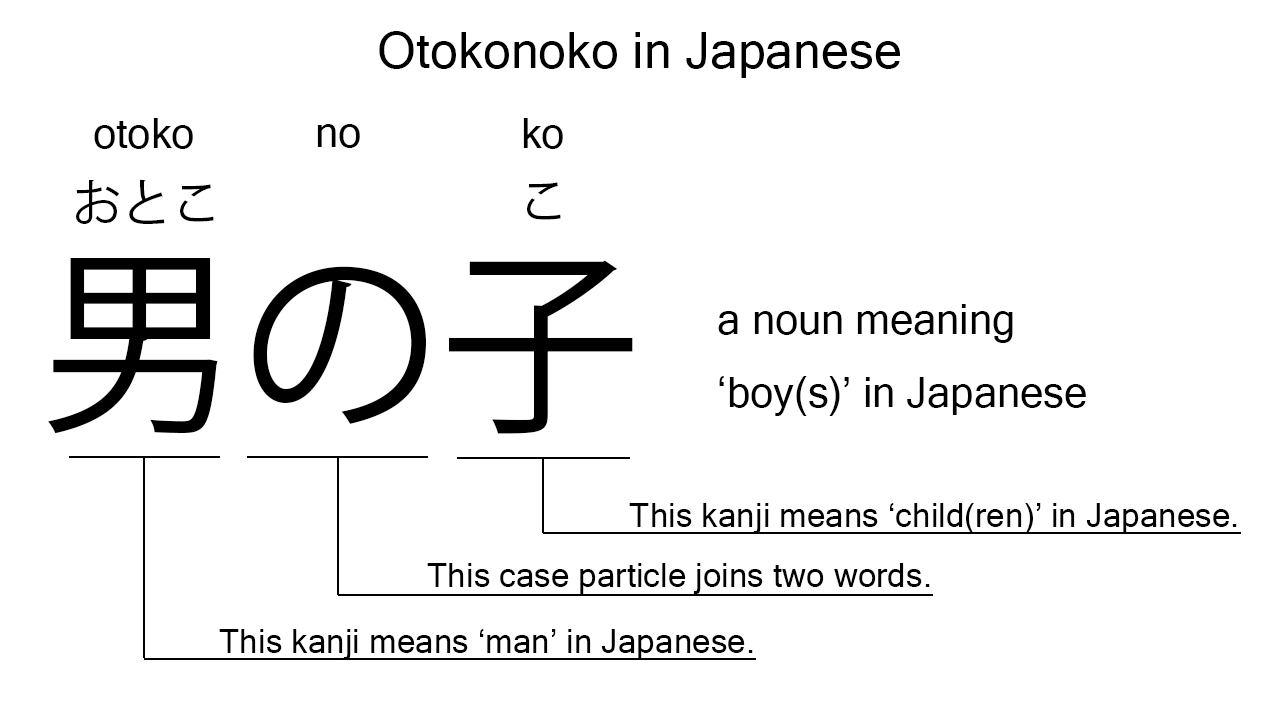What does “otokonoko” mean in Japanese?
Native speakers say “otokonoko” to mean ‘boy’ in Japanese. Perhaps, some Japanese learners know this word as it is sometimes used in Japanese movies, songs, novels, manga, anime, and the like. In this blog post, however, I will explain this word in detail based on its grammatical components. And also, I will explain how to use it through example sentences. My explanations would help Japanese learners understand “otokonoko” more clearly. Then, let’s get started!
Contents
Definition and meaning of “otokonoko”
Let me start with the definition and meaning of “otokonoko”.
- otokonoko – 男の子 (おとこのこ) : a noun meaning ‘boy’ in Japanese. This can also work as plural. Learn more about Japanese plural.
The definition and meaning are simple and clear. To understand this noun more clearly, however, let me explain its grammatical components in detail, one by one.
What does “otokonoko” literally mean in Japanese?
“Otokonoko” consists of the following three components:
- otoko – 男 (おとこ) : a noun meaning ‘man’ or ‘male’ in Japanese.
- no – の : a case particle joining two nouns. Normally, the first one can work as a modifier to describe the second.
- ko – 子 (こ) : a noun meaning ‘child’ or ‘kid’ in Japanese.
These three components tell us that “otokonoko” literally means a ‘male child’ in Japanese. This literal interpretation is completely in line with the actual meaning.

When we meet new Japanese words, we should check their grammatical components in detail to understand their meanings clearly and deeply. In many cases, components tell us a lot about the meanings of the words they form. Actually, here, we could get the better understanding of “otokonoko” through the detailed check above.
So far, I’ve explained the definition and meaning of “otokonoko” together with its grammatical components. Then, let me explain how to use it through the example sentences below.
Example #1: how to say “boy” in Japanese
otokonoko ga ie ni ki ta – 男の子が家に来た (おとこのこがいえにきた)
A boy came to my house.
Below are the new words used in the example sentence.
- ga – が : a case particle used to make the subject word or the object word in a sentence. In the example, this is used after “otokonoko” to make the subject in the sentence.
- ie – 家 (いえ) : a noun meaning ‘house’ in Japanese. This can also work as plural.
- ni – に : a case particle used to say where someone or something goes. In the example, this is used after “ie” to indicate the place where the boy came.
- ki – 来 (き) : one conjugation of the verb, “kuru“, which means ‘to come’ in Japanese. In the example, it has been conjugated for the better connection with its following word.
- ta – た : an auxiliary verb used after a verb, adjective, or auxiliary verb to make its past tense form. Probably, this is well known as a part of Japanese ta form. In the example, this is used after “ki” to make its past tense form, “ki ta”.
This is a typical usage of “otokonoko”. In the example, it works together with the case particle, “ga”, to become the subject in the sentence.
Example #2: another usage of “otokonoko”
sono otokonoko wa mada totemo osanakat ta – その男の子はまだとても幼かった (そのおとこのこはまだとてもおさなかった)
That boy was still very young.
Below are the new words used in the example sentence.
- sono – その : a determiner used before a noun which refers to something not close to the speaker. In the example, this is used before “otokonoko” to mean ‘that boy’ in Japanese.
- wa – は : a binding particle working as a case marker or topic marker. In the example, this works after “sono otokonoko” to make the subject in the sentence.
- mada – まだ : an adverb meaning ‘still’ or such in Japanese.
- totemo – とても : an adverb of degree meaning ‘very’, ‘much’, ‘so’, or such in Japanese. In the example, this works in front of “osanakat ta” to emphasize its meaning.
- osanakat – 幼かっ (おさなかっ) : one conjugation of the i-adjective, “osanai“, which means ‘very young’ or just ‘young’ in Japanese. In the example, it has been conjugated for the better connection with its following word.
This is another typical usage of “otokonoko”. In this example, it works together with the determiner, “sono”, to mean ‘that boy’ in Japanese. When we want to refer to a boy or boys in Japanese, anyway, this noun is always a very good option.
Summary
In this blog post, I’ve explained the definition and meaning of “otokonoko” in detail based on its grammatical components. And also, I’ve explained how to use it through the example sentences. Let me summarize them as follows.
- otokonoko – 男の子 (おとこのこ) : a noun meaning ‘boy’ in Japanese. This can also work as plural. These three characters literally mean a ‘male child’ in Japanese. So, what the characters express is completely in line with the actual meaning. When we want to refer to a boy or boys in Japanese, this noun is always a very good option.
Hope my explanations are understandable and helpful for Japanese learners.